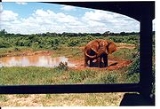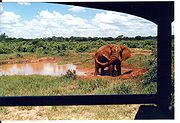
Wildlife tourism
Encyclopedia


Ecosystem
An ecosystem is a biological environment consisting of all the organisms living in a particular area, as well as all the nonliving , physical components of the environment with which the organisms interact, such as air, soil, water and sunlight....
and animal
Animal
Animals are a major group of multicellular, eukaryotic organisms of the kingdom Animalia or Metazoa. Their body plan eventually becomes fixed as they develop, although some undergo a process of metamorphosis later on in their life. Most animals are motile, meaning they can move spontaneously and...
friendly tourism, usually showing animals in their natural habitat. Wildlife
Wildlife
Wildlife includes all non-domesticated plants, animals and other organisms. Domesticating wild plant and animal species for human benefit has occurred many times all over the planet, and has a major impact on the environment, both positive and negative....
tourism
Tourism
Tourism is travel for recreational, leisure or business purposes. The World Tourism Organization defines tourists as people "traveling to and staying in places outside their usual environment for not more than one consecutive year for leisure, business and other purposes".Tourism has become a...
, in its simplest sense, is watching wild animals
Wildlife
Wildlife includes all non-domesticated plants, animals and other organisms. Domesticating wild plant and animal species for human benefit has occurred many times all over the planet, and has a major impact on the environment, both positive and negative....
in their natural habitat
Habitat
* Habitat , a place where a species lives and grows*Human habitat, a place where humans live, work or play** Space habitat, a space station intended as a permanent settlement...
. Wildlife tourism is an important part of the tourism industries in many countries including many African and South American countries, Australia, India, Canada, Indonesia, Bangladesh, Malaysia and Maldives among many. It has experienced a dramatic and rapid growth in recent years world wide and is closely aligned to eco-tourism and sustainable-tourism.
Wildlife tourism is also a multi-million dollar industry offering customized tour packages and safaris.
Negative Impacts of Wildlife Tourism
Wildlife tourism can cause significant disturbances to animals in their natural habitats. The growing interest in traveling to developing countries has created a boom in resort and hotel construction, particularly on rain forest and mangrove forest lands. Wildlife viewing can scare away animals, disrupt their feeding and nesting sites, or acclimate them to the presence of people. In Kenya, for example, wildlife-observer disruption drives cheetahs off their reserves, increasing the risk of inbreeding and further endangering the species.Direct Impacts
The effect that wildlife tourism will have on wildlife depend on the scale of tourist development and the behavior and resilience of wildlife to the presence of humans. When tourists activities occur during sensitive times of the life cycle (for example, during nesting season
Nesting season
The nesting season is the time of year during which birds and some other animals, particularly some reptiles, build nests, lay eggs in them, and in most cases bring up their young. It is usually in the spring....
), and when they involve close approaches to wildlife for the purpose of identification or photography, the potential for disturbance is high. Not all species appear to be disturbed by tourists even within heavily visited areas.
Disturbing Breeding Patterns
The pressures of tourists searching out wildlife to photograph or hunt can adversely affect hunting and feeding patterns, and the breeding success of some species. Some may even have long-term implications for behavioral and ecological relationships. For example, an increase in boat traffic has disturbed the feeding of giant otters in Manu National Park
Manú National Park
Manú National Park is a biosphere reserve located in Madre de Dios and Paucartambo, Cusco. Before becoming an area protected by the Peruvian government, the Manú National Park was conserved thanks to its inaccessibility. The park remains fairly inaccessible by road to this day. In 1977, UNESCO...
, Peru
Peru
Peru , officially the Republic of Peru , is a country in western South America. It is bordered on the north by Ecuador and Colombia, on the east by Brazil, on the southeast by Bolivia, on the south by Chile, and on the west by the Pacific Ocean....
. Further disturbance to wildlife occurs when tourist guides dig up turtle
Turtle
Turtles are reptiles of the order Testudines , characterised by a special bony or cartilaginous shell developed from their ribs that acts as a shield...
nests and chase swimming jaguars, tapirs and otters to give clients better viewing opportunities. On the shores of Lake Kariba
Lake Kariba
Lake Kariba is the world's largest artificial lake and reservoir. It lies 1300 kilometers upstream from the Indian Ocean, along the border between Zambia and Zimbabwe...
in Zimbabwe
Zimbabwe
Zimbabwe is a landlocked country located in the southern part of the African continent, between the Zambezi and Limpopo rivers. It is bordered by South Africa to the south, Botswana to the southwest, Zambia and a tip of Namibia to the northwest and Mozambique to the east. Zimbabwe has three...
, the number of tourist boats and the noise generated as disrupted the feeding and drinking patterns of elephants and the black rhinoceros
Black Rhinoceros
The Black Rhinoceros or Hook-lipped Rhinoceros , is a species of rhinoceros, native to the eastern and central areas of Africa including Kenya, Tanzania, Cameroon, South Africa, Namibia, Zimbabwe, and Angola...
- it is feared that further increases in boat traffic will affect their reproductive success.
Disturbing Feeding Patterns
Feeding of wildlife by tourists can have severe consequences for social behavior patterns. Artificial feeding by tourists caused a breakdown of the territorial breeding system of land iguanas on the South Plaza in the Galapogos Islands. Territories were abandoned in favor of sites where food could be begged from tourists, and this has had a negative effect on the breeding success of iguanas. Artificial feeding can also result in a complete loss of normal feeding behaviors. In the Galapagos Islands, overfeeding by tourists was so extreme that, when stopped, some animals were unable to locate their natural food sources. Similarly, until the early 1970s, the diet of some Grizzly bears in Yellow Stone National Park (USA) consisted, to a large extent, of food wastes left by visitors at park refuse sites. When these sites were closed, the beats showed significant decreases in body size, reproductive rate and litter size.
Disruption of parent-offspring bonds
Wildlife tourism can also cause disruption to intra-specific relationships. Attendance by female harp seals to their pups declined when tourists were present in Canada's Gulf of St Lawrence, and those females remaining with their pups spent significantly less time nursing and more time watching the tourists. There is also a risk of the young not being recognized, and being more exposed to predator attacks. A similar concern has been expressed over whale watching
Whale watching
Whale watching is the practice of observing whales and other cetaceans in their natural habitat. Whales are watched most commonly for recreation but the activity can also serve scientific or educational purposes. A 2009 study, prepared for IFAW, estimated that 13 million people went whale watching...
, whale calves normally maintain constant body contact with their mothers but, when separated, can transfer their attachment to the side of the boat.
Increased vulnerability to predators and competitors
The viewing of certain species by wildlife tourists can make that species more vulnerable to predators. Evidence of this phenomenon has been recorded in birds, reptiles and mammals. Problems have occurred in breeding colonies of brown pelicans visited by tourists in Mexico
Mexico
The United Mexican States , commonly known as Mexico , is a federal constitutional republic in North America. It is bordered on the north by the United States; on the south and west by the Pacific Ocean; on the southeast by Guatemala, Belize, and the Caribbean Sea; and on the east by the Gulf of...
. Breeding success decreased by 52-100% in visited sites compared to unvisited sites.
Positive Impacts of Wildlife Tourism
Habitat restoration by eco-lodges and other tourism operationsMany owners of eco-accommodation or wildlife attractions preserve and restore native habitats on their properties
Conservation breeding
Many wildlife parks (e.g. David Fleay Wildlife Park, Gold Coast, Australia) and zoos breed rare and endangered species as a major part of their activities, and release the progeny when possible into suitable habitat.
Financial donations
Some wildlife tourism contributes monetary donations to conservation efforts (e.g. Dreamworld, Gold Coast, has a display of Sunatran tigers, and money from visitor donations and from their 'tiger walk' goes to Sumatra to assist in-situ conservation of wild tigers.
Quality interpretation
A good wildlife guide will impart a deeper understanding of the local wildlife and its ecological needs, which may give visitors a more informed base on which to subsequently modify their behaviour (e.g. not throw out plastic bags that may be eaten by turtles) and decide what poiltical moves to support.
Research and monitoring
Some wildlife tourism operations contribute to monitoring of wildlife numbers or general research relevant to conservation
Anti-poaching
Bringing tourists regularly into some areas may make it more difficult for poachers of large animals or those who collect smaller species for the black market
External links
Wildlife Tourism in Australia and Asia- http://www.wildlifetourism.org.au Wildlife Tourism Australia is a national association supporting the wildlife tourism industry (including free-ranging and captive wildlife) and conservation of wildlife and their habitats. The website includes a very extensive bibliography
- South-East Asian Tourism Organisation A new South-east Asian based organisation looking at ways to use agritourism and other initiatives to spread the benefits of tourism more widely.
- http://www.wildlifeexplorer.com.au - Wildlife Explorer takes small groups into the World Heritage Area forests of tropical northern Australia in search of the unique wildlife found in these ancient and beautiful places.
- http://en.wikipedia.org/wiki/Sundarbans - Sundarbans is the largest wildlife mangrove forest in the world.It situated mainly in southern part of Bangladesh. The UNESCO has announced it for world heritage in 1997.
- http://www.sustainabletourismonline.com/wildlife-tourism - This leads to many reports published by the Wildlife Tourism sector of the Sustainable Tourism Cooperative Research Centre (Australia)

